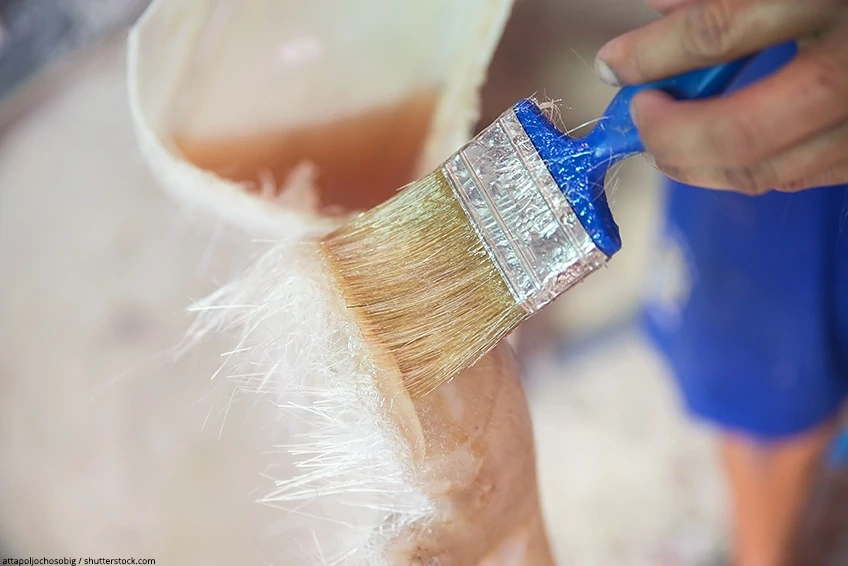How to get Fiberglass out of Skin – Prevent Symptoms
This post may contain affiliate links. We may earn a small commission from purchases made through them, at no additional cost to you. You help to support resin-expert.com
When working with fiberglass, experts will tell you to take certain precautions. This material can easily cause some uncomfortable problems, especially if it comes into contact with the skin. This article is to help you understand why you should be cautious, how you can safely remove fiberglass from the skin and a few tips to help you out.
Table of Contents
What are Fiberglass fibers?
The fiberglass material is made of plastic and glass fiber. The synthetic material can be purchased in a flat sheet, also known as a chopped strand mat, or a woven fabric. When the fiberglass is cut or sanded, the fiberglass dust gets into the air. When not wearing protective gear, they can cause fiberglass skin irritation, eye irritation, and even irritate the lungs if breathed in.
Fiberglass is generally safe if you follow all the safety precautions and it is correctly installed or used. For example, if it is installed during a building project, it is usually located between panels and plaster etc. During renovations or when it is removed, it will become a hazard. There have been suggested alternatives to fiberglass, such as cork or other forms of insulation.
The roof or attic remains the most exposed area for fiberglass. In most cases, you will have to crawl or touch fiberglass material in these areas. Fiberglass is also used in the building of boats, cars, bathtubs, pipes, surfboards and numerous other applications. You should, therefore, take extra care and follow all safety precautions whenever you are working with fiberglass materials.
Why fiberglass can burn your skin
Many homeowners understand the feeling of fiberglass burn. Insulation in the ceiling of the house and around the geyser can be made of fiberglass wool, if you go to check out a minor leak or something else in the roof, you should take care of what you might be coming into contact with.
Fiberglass is used in many other applications, and the most common problem experienced, is skin irritation. The needle-like fibers can easily get into the skin, which you might scratch because it is itchy. Scratching is not a good idea and can result in a nasty fiberglass rash and a burning sensation..
Removing Fiberglass from the skin
How to get rid of fiberglass itch? There are a few ways to get rid of fiberglass in the skin, which should help provide fiberglass itch relief. The best way to stop fiberglass itch is to remove the nasty fibers. Following are a few ideas:
- One fiberglass itch remedy is to apply some tape to the affected area. Make sure to do this in a well-lit space, so you can see where the fiberglass is lying. Find some tape, one that is really sticky, and gently apply to the area. You don’t want to press hard and push the fibers further into the skin. Keep the tape on for a minute or two and pull off. The fibers should stick to the tape. Check the area to make sure all of the fiberglass has been removed. To check, gently rub over the area with your thumb, you will soon know if there is still any in the skin. Apply tape again until all the fiberglass is gone.
- Soak your hand or arm in some warm soapy water. You can also add some Epsom salts, which can draw the fibers to the surface. Remove the affected area from the water, take a pair of pantyhose and gently rub over the area. The fibers should cling to the pantyhose.
- You can pluck the fiberglass slivers from the skin with a tweezer. First, clean the area. Gently pour some soapy water over the affected area, you do not want to rub. You should also clean the tweezer and needle if using one. To remove the slivers, you should be in a space that provides good lighting.
- Some recommend using a good quality hair conditioner. The conditioner, as it coats and softens your hair, so it seems to do to the fiberglass splinters. This then helps to remove them from the skin much more easily.
How to remove fiberglass from the eyes
The fiberglass fibers are quite small and can, therefore, get into the eyes quite easily. The fibers can get stuck in the eyeball, underneath the eyelids and also lodge in the corners of the eye. This can be painful, causing irritation and redness.
Of, course, it is natural to want to scratch your eye. You mustn’t scratch your eye, as this could cause damage. You will need to clean your eye out, and this should be done by a medical professional.
When working with fiberglass, and you do not wear any protective eye gear, make sure to rinse your eyes out even if there is no immediate irritation after you have finished your work. The lesson here is, always wear protective gear.
What are the Health Risks with Fiberglass?
When working with fiberglass, it could create fiberglass dust, which lands on the skin. The fine fibers or splinters can then lodge painfully and cause a fiberglass skin rash. If this is not dealt with, it could cause contact dermatitis. Besides fiberglass skin irritation, there are other health risks:
- The fiberglass could cause eye irritation.
- It could trigger asthma, bronchitis and irritate the respiratory system
- May even irritate the stomach if swallowed
Breathing in Fiberglass
There is no evidence to show any long-term health effects of fiberglass on the lungs. Obviously, wearing proper protective gear will prevent any issues. On occasion, a small amount might be inhaled, which could cause soreness in the nose and throat area. Chronic conditions like asthma or bronchitis could also be aggravated by the small fibers entering the lungs. One recommendation for removing fibers from the respiratory tract is to try coughing. Otherwise, seek medical attention if you feel it is more serious.
Tips on how to work with Fiberglass
By following a few basic rules when working with fiberglass, you can avoid any problems like a fiberglass rash or itch. Here are a few tips:
- When you know an item contains fiberglass, do not touch it with your bare hands
- Get yourself some gloves to protect your hands.
- Other recommended protective gear includes eye protection or goggles and a particulate respirator. Make sure your eye protection covers your entire eye, including the sides.
- You can also dress appropriately in clothes that have long sleeves, long pants and is loose-fitting.
- Once you have completed your work, remove the work clothing straight after you have finished.
- Wash the clothes separately and make sure to rinse the washing machine afterwards.
- Concerning the work area, do not sweep or stir up dust, rather use a vacuum cleaner or a wet mop. The vacuum cleaner should have a proper particulate air filter.
- Work in a well-ventilated area.
- Take a shower yourself when the work with the fiberglass is done. Some fiber glass may still get onto your skin.
- Flush your eyes out with water just as insurance, even if you have been wearing goggles.
- If you do find fibers in your skin, do not rub or scratch, as this will push the fine splinters further into the skin.
- And if the work can be done by somebody else, rather get in a professional in to do the job.
Fiberglass itch, when to see a doctor
If you do not work with fiberglass regularly, doing a simple job with fiberglass should not be a problem. Just follow the rules and tips in order to prevent a fiberglass itch. People who work with fiberglass every day might see a few more problems.
In either case, if you find that you have tried everything recommended and you are still experiencing a fiberglass skin irritation, it could be some fibers still sticking around, or it could be contact dermatitis. If the problem persists, you should seek out medical advice.
A fiberglass itch remedy will be most welcome in this case. After removing the fine fiberglass splinters, you might have to apply a steroid ointment, which will help to prevent infection and also aids in reducing any inflammation. A doctor may also prescribe some antihistamines.
Fiberglass and your skin questions and answers
How long can fiberglass remain on the skin?
Not for long, as you will know it is on the skin because of the irritation it causes. In cases, where you are not sure of the cause of your skin irritation, it can remain on the skin until the problem is resolved.
Fiberglass on the skin, what should you be looking out for?
You will definitely be feeling discomfort along with an intense itch. You might be able to see small, fine, white, or yellow fibers sticking out of the skin, which will cause a rash and inflammation.




